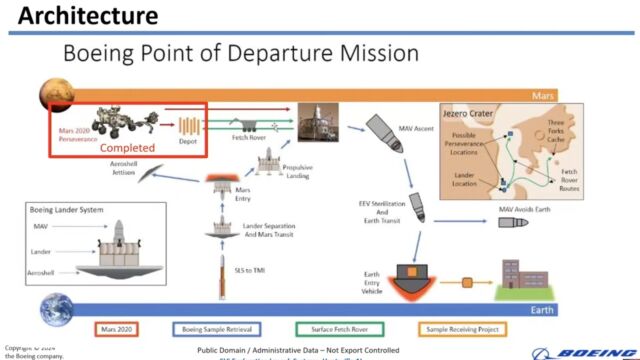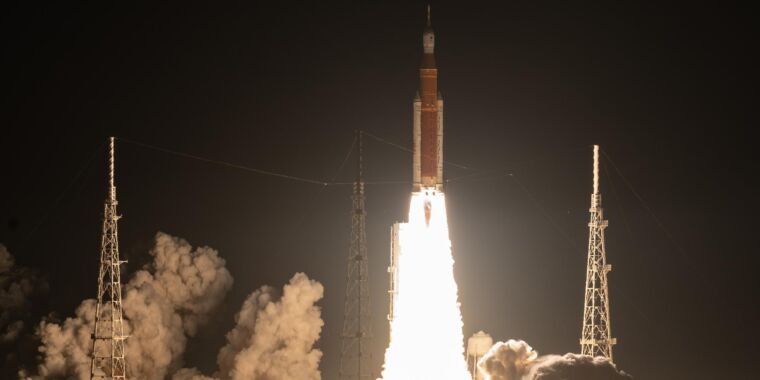NASA is looking for ways to obtain rock samples from Mars for less than the $11 billion the agency would need under its own plan, so officials last month put out a call to industry to propose ideas.
Boeing is the first company to release details about how it will attempt a Mars sample return mission. Her study includes a single flight of a Space Launch System (SLS) rocket, an extra-heavy launcher designed to send astronauts to the moon on NASA’s Artemis missions.
Jim Green, former NASA chief scientist and longtime head of the agency’s planetary science division, presented Boeing’s concept Wednesday at the Humans to Mars summit, an annual event sponsored primarily by traditional space companies. Boeing is the prime contractor for the SLS core stage and upper stage and has installed the SLS system, primarily a crew launch vehicle, as a rocket for military satellites and deep space probes.
All in one
Green, now retired, said the concept he and Boeing engineers are proposing would reduce the risks of returning a Mars sample. With a single mission, there are fewer potential points of failure, he said.
“To reduce mission complexity, this new concept performs a single launch,” Green said.
This argument makes some sense, but the problem is that the SLS is the most expensive rocket flying today. Even if NASA and Boeing take cost-cutting measures, NASA’s inspector general reported last year that the cost of a single SLS launch was unlikely to fall below $2 billion. The inspector general recommended that NASA consider purchasing commercial rockets as an alternative to the SLS system for future Artemis missions.
NASA’s Perseverance rover, which has been operating on Mars since February 2021, collects soil and rock samples and seals them in 43 cigar-sized titanium tubes. The rover dropped the first 10 of these tubes into a repository on Mars that could be recovered by a future sample return mission. The remaining tubes will likely remain stored aboard Perseverance in the hope that the rover will deliver samples directly to the spacecraft that comes to Mars to obtain them.

Boeing
In his remarks, Green praised the benefits of launching a Mars sample return mission with a single rocket and a single spacecraft. NASA’s basic concept involves two launches, one with an American-made lander and small rocket to boost the rocket’s samples from the surface of Mars, and one with a European spacecraft to rendezvous with the sample carrier in orbit around Mars, then bring the spacecraft back. Return samples to Earth
“This concept is a single launch vehicle,” he said. “It’s an SLS. What does it do? It’s carrying a huge payload. What’s the payload? It’s an aerospace projectile to get into Mars and get down. It has a thruster landing module.”
The lander will carry everything needed to return the samples to Earth. A fetch rover will be deployed aboard the lander to launch and pick up sample tubes collected by Perseverance. Then, a robotic arm moves the sample tubes into a container at the top of a two-stage rocket called a Mars Ascent Vehicle (MAV) located on top of the lander. The MAV will have the gravity needed to lift samples from the surface of Mars into orbit, then direct fire engines to target a return path to Earth.
Boeing has no direct experience as a prime contractor for any mission to Mars. SpaceX, with its giant Starship rocket designed for eventual Mars missions, and Lockheed Martin, which has built several Mars landers for NASA, are the two companies with the technology and expertise that appear most useful for returning Mars samples.
NASA is also collecting ideas about Mars sample returns from its space centers across the United States. The agency also commissioned JPL, which was responsible for developing the original concept upon arrival, to come up with a better idea. Later this year, NASA officials will refer to these new proposals when deciding how to proceed with the Mars sample return process, with the goal of obtaining samples from Mars in the 2030s.

“Typical beer advocate. Future teen idol. Unapologetic tv practitioner. Music trailblazer.”






More Stories
NASA’s Perseverance rover has found a rock on Mars that may indicate ancient life.
Northern Lights May Shine in Some States Tonight
NASA Releases Never-Before-Seen Images of the Peacock Galaxy 25 Years After Chandra X-ray Observatory Launch